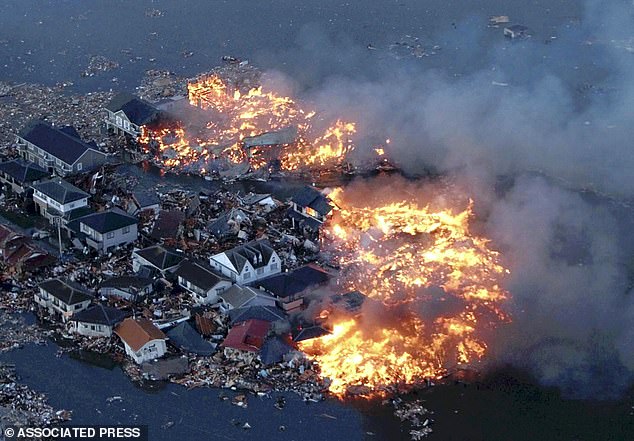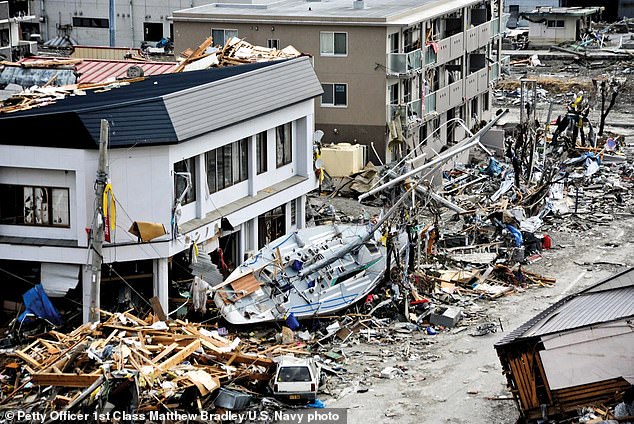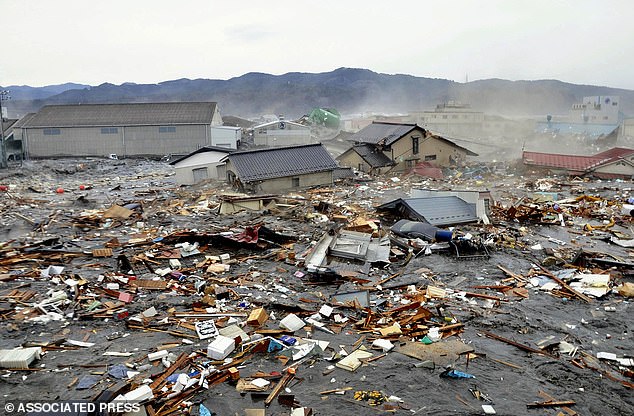A major fault line off the west coast could trigger a catastrophic magnitude 9 earthquake, research shows – and it’s due to a blow
An underwater fault line along America’s west coast could trigger a megaquake that would be more devastating than California’s ‘Big One’, a new study suggests.
Using underwater mapping techniques, scientists have mapped the Cascadia Subduction Zone – a 600-mile-long fault line stretching from southern Canada to Northern California – in unprecedented detail.
It has been found that the fault splits into four segments rather than being one continuous strip like most faults. The discovery could be even more catastrophic because the tectonic plates could slide under each other, creating more pressure and bigger earthquakes.
The researchers concluded that the Cascadia Subduction Zone has the potential to unleash an earthquake of greater than nine magnitude.
The Cascadia Subduction Zone extends along a 600-mile stretch of the Pacific Ocean off the coasts of southern Canada, Washington, Oregon and northern California. If it erupts, it could cause a magnitude 9 earthquake to hit the region. The darker areas mark the region that would suffer the most damage and extend inland where the devastation would be more moderate

If the fault were to rupture, it could last about five minutes and cause tsunamis as high as 100 feet (30 meters), damaging more than half a million buildings and killing countless people in its wake. Pictured: A magnitude 9.0 earthquake devastated Japan in 2011
For comparison, California’s San Andreas is ready for an earthquake with a magnitude of up to 8.3.
If an earthquake of magnitude greater than 9 were to strike the US West Coast, it could trigger tsunamis that could reach 100 feet or more in height, kill more than 10,000 people and cost more than $80 billion in Oregon and Washington alone could cause damage.
Disaster emergency plans in Oregon and Washington warn that in the aftermath of such a large earthquake, they could face a wave of long-term deaths from diseases due to exposure to dead bodies, animal carcasses, contaminated water and hazmat spills from commercial, industrial and domestic sources.
A similar fault zone off the coast of Japan erupted in 2011, triggering a magnitude 9 earthquake that caused a devastating tsunami that hit the country, killing nearly 20,000 people.
Now scientists worry that a similar disaster could hit the US in the coming years. They report that earthquakes caused by Cascadia occur approximately every 500 years, with the last occurring in 1700.
“The return interval for this major event subduction zone is on the order of 500 years,” Wang said.
“It’s hard to know exactly when it will happen, but if you compare this to other subduction zones, it’s certainly quite late.”
Cascadia’s four segments make it more dangerous than other major faults because they contain different rocks and sediments, with the most worrisome section extending along northern Oregon into Washington and southern British Columbia.
“It requires a lot more research, but for places like Tacoma and Seattle it could mean the difference between alarming and catastrophic,” said co-author Harold Tobin, a geophysicist at the University of Washington.
This part of Cascadia is flatter and smoother than the other three parts, meaning it could produce the largest earthquakes, extend further into the US and affect all of Washington’s coastal communities.

An earthquake measuring nine on the Richter scale in the northwestern US could destroy half a million homes and kill countless people. In the photo: the aftermath of the magnitude 9.0 earthquake that struck Japan in 2011
“We have the potential for earthquakes and tsunamis as large as the largest we have experienced on Earth,” Tobin told NBC News.
“Cascadia seems capable of generating a magnitude nine, or slightly smaller or slightly larger.”
Suzanne Carbotte, lead author of the study and a marine geophysicist at the Lamont-Doherty Earth Observatory, said this is the first clear image of the Cascadia zone, adding that all emergency models are based on “old, low-quality data from the eighties’.
The researchers hope their findings will help states in the impact zone prepare for a worst-case emergency response and evacuation if the Cascadia Subduction Zone ruptures.

If an earthquake of this magnitude were to strike, it could trigger tsunamis that could reach 100 feet (30 meters) high or more, effectively changing the region. A similar fault zone off the coast of Japan caused the devastating tsunami that hit the country in 2011, killing (pictured) almost 20,000 people.
Neither Oregon nor Washington state are adequately prepared for these types of disasters because of the limited information in the 1980s Cascadia model, the researchers said.
However, they said new preparedness assessments could be published as early as next year.
The map of the subduction zones was created using active source seismic imaging – which transmits sounds to the ocean floor and processes the echoes – providing a sharper insight into how this can affect the environment.
Researchers from the Columbia Climate School attached a streamer – a 15-kilometer-long cable – to the back of the boat, which used 1,200 hydrophones that captured the echoes to update their ocean acoustic tomography models that provide images of the fault.
Hydrophones measure the amount of time it takes for sound to bounce off structures on the ocean floor and reach the surface, allowing them to detect the differences in the height of rocks that indicate recently active fault lines.
‘The accuracy and resolution are truly unprecedented. And it’s an amazing data set,” Kelin Wang, a research scientist at the Geological Survey of Canada who was not involved in the study, told me. NBC News.
‘It just allows us to better assess the risk and have information for building codes and zoning regulations.’
